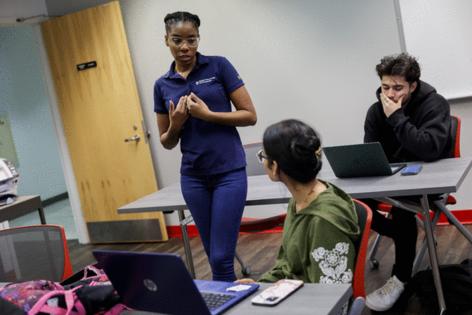Editorial: How much is tuition really? Your favorite college does not want you to know
Published in Op Eds
For high school seniors from the Class of 2024 who plan to attend college in the fall, these are tense days.
The traditional May 1 deadline for picking a school is fast approaching. At the same time, Uncle Sam is making the painful process of applying for financial aid extra difficult this year. Colleges and universities are up to their usual game of hiding the true amounts they intend to charge until the last possible moment. And President Joe Biden is throwing in a new wrinkle, arbitrarily forgiving the college loans of some students, but not others, a pretty naked attempt not just to put a thorn in the side of the Supreme Court but to win more votes ahead of the Nov. 5 election.
America sure makes going to school complicated. In fact, the process has become so fraught that some schools are bracing for a significant decline in enrollment this year.
The red tape and high costs have become such a burden that part of the expected student population is giving up on the whole idea — and who can blame them?
The federal government owes everyone an apology for the botched rollout of its new Free Application for Federal Student Aid. Filling out the FAFSA, as it’s called, is a rite of passage for incoming students and their middle-class families, combining the tedium of tax time with the complication of an unfamiliar government bureaucracy.
Making matters worse is a federal law ironically titled The FAFSA Simplification Act, which beginning this year imposed big changes on how the government determines financial aid eligibility. The law affects Illinois and every other state that uses FAFSA data to award its grants for students, as well as every school that participates in federal student aid programs, which is most of them.
So far, the Orwellian “Simplification Act” has turned college admissions into an even more complicated mess. The U.S. Department of Education was months late in issuing the new FAFSA, then it belatedly woke up to a slew of errors that resulted in faulty determinations of how much aid a student is entitled to. It’s still trying to correct inaccurate calculations that it previously transmitted to colleges.
The upshot is that financial aid award letters, which usually arrive during the same early spring period as offers of admission, were in many cases delayed this year. Instead of having weeks to consider their options, some families are still waiting for crucial information about how much the entire miserable business will ultimately cost them. While some schools have extended deadlines to help accommodate the delays, others have refused. Evidently, they expect families to give them an answer about attendance without knowing the relevant amounts in each part of a complicated financial aid puzzle that typically includes grants, scholarships, loans and subsidized jobs.
For some, this year’s college experience will be like buying a car without knowing how much it costs or how it will be paid for. Car dealers, in fact, are models of transparency compared with their counterparts selling higher education.
The nonprofit Brookings Institution earlier this month unveiled a report about the shenanigans behind college pricing titled “Ignore the Sticker Price,” a reference to the fact that few students pay the actual listed price that schools say they charge.
Instead, colleges employ a slippery sliding scale that makes it all but impossible to compare the cost of one school with another until the final decision point — and even then, costs can change from year to year.
These are the same schools that in many cases had no qualms charging full price for inferior remote learning during COVID-19, and in some cases billed for activities and campus services that were shut down during the pandemic. Why would families mind paying for big gym fees and the like, even though the gym was closed and the students were working from home? They can just borrow more money, after all.
Brookings has calculated that only 26% of in-state public college students and 16% of those enrolled in more expensive private institutions paid the easily visible sticker price as of 2019-2020. That was down from roughly double those numbers paying sticker in the mid-1990s. Even many high-income families typically receive so-called merit aid or other discounts off the sticker price.
How much do people pay? Good luck figuring that out.
As the Brookings report concludes, “Our current system of setting and communicating college prices does notwork. We cannot expect students to make sound decisions regarding educational investments if they do not understand how much college will actually cost them.” Wealthy parents are better positioned to weather the ambiguity, but this lack of fiscal clarity especially hurts families sending their first generation to college.
Further complicating the matter, Biden is still playing Santa Claus with taxpayer money, forgiving tens of billions in college loans on the thinnest pretexts. Those giveaways ultimately reduce the incentives for schools to economize and operate more efficiently, pushing up tuition and fees.
This multipronged pricing racket has worn out everyone’s patience. America’s colleges and universities, supposedly one of the nation’s greatest assets, have got to start giving families straight answers.
___
©2024 Chicago Tribune. Visit at chicagotribune.com. Distributed by Tribune Content Agency, LLC.







Comments